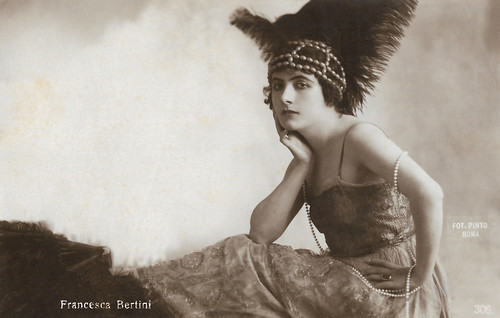
Italian postcard by Ed. A. Traldi, Milano, no. 306. Photo: Pinto, Roma.

Italian postcard by Edizioni A. Traldi, Milano, no. 401. Photo: Pinto, Roma.

Italian postcard by Edizioni A. Traldi, Milano, no. 442.

Italian postcard by Fotocelere, Torino, no. 324.
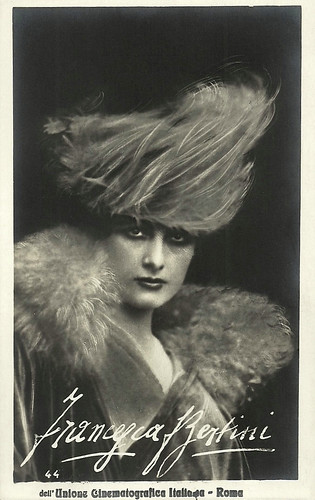
Italian postcard by La Rotofotografica, no. 44. Photo: Unione Cinematografica Italiana, Roma.
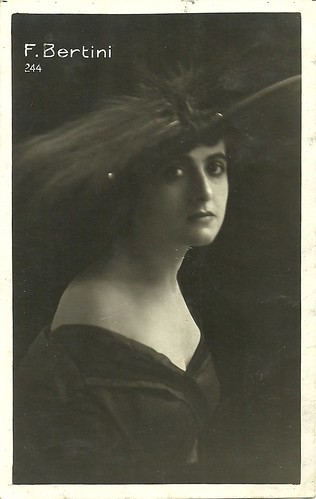
Italian postcard by Ed. G. Vettori, Bologna, no. 244.

Italian postcard by G. Vettori, Bologna, no. 401.
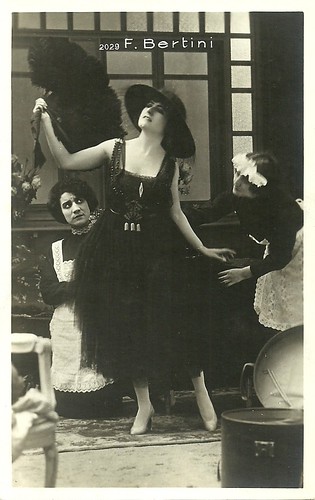
Italian postcard by Ed. G. Vettori, Bologna, no. 2029.
Strong, intense, and charming personality
Francesca Bertini was born Elena Taddei in an orphanage in Firenze (Florence), Italy in 1892. She was the daughter of Adelina di Venanzio Fratiglioni, a single mother and possibly a stage actress. She became Elena Vitiello in 1910 when her mother married Arturo Vitiello, a Neapolitan propman or furniture dealer. Bertini began performing on stages as a child, particularly in Naples, where her family was settled. In 1904, at the age of 16, she moved to Rome, where she improved her acting skills, especially on theatre stages, and attempted to perform in the just-born Italian cinema.
She made her film debut in La dea del mare/The Goddess of the Sea (?, 1909), by Film d'Arte Italiana (Pathé Frères). There she made some 15 films between 1909 and 1912. Then she appeared in many one-, two- and three-reelers for the Italian pioneering companies Cines and Celio. Gradually she developed her beauty and elegance, plus a strong, intense, and charming personality, which would be the key to her success as a silent film actress.
Her first important film was Histoire d'un pierrot/Pierrot the Prodigal (Baldassarre Negroni, 1914). Soon followed by appearances in L'amazzone mascherata/The Masked Amazon (Baldassarre Negroni, 1914) and Sangue bleu/Blue Blood (Nino Oxilia, 1914).
Bertini was the most versatile of the big three Italian Divas - Bertini, Lyda Borelli, and Pina Menichelli. Her strong face and dignified suffering carried a large number of films, now mostly lost. However, one of her most impressive films has survived: Assunta Spina (Francesca Bertini, Gustavo Serena, 1915).
David Melville reviews on IMDb: "Assunta Spina is a work of dazzling dramatic intensity - with a heroine who is striking in her sensuality and modernity. Unlike the languid paper dolls that populate silent films by Griffith and others, Francesca Bertini plays a fully sexual woman. A vulnerable but hard-headed child of the slums, she's not above flirting with a man who's not her fiance, or - once the fiance goes to jail for attacking her in a jealous rage - prostituting herself to an official in order to save him. Not a Madonna, not a whore, but a woman. Perhaps the first real woman in screen history." Bertini did not just play the role of the main character, but she also wrote the script, and directed and produced the film. Later, she directed herself again in one of her other famous roles, Tosca, in Tosca (1918).

Italian postcard by Ed. Soc. Anon. It. Bettini, Roma, no. 108. Photo: Bettini, Roma.
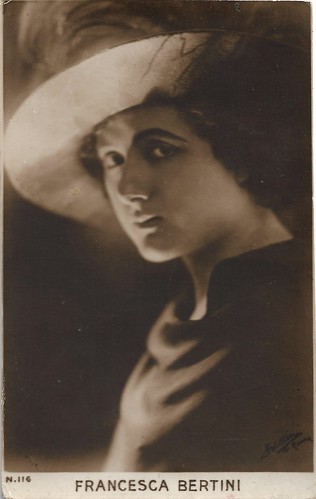
Italian postcard by Ed. Soc. Anon. It. Bettini, Roma, no. 116. Photo: Bettini, Roma.

Italian postcard, no. 5558. Francesca Bertini and Gustavo Serena in a dressing room, film unknown.
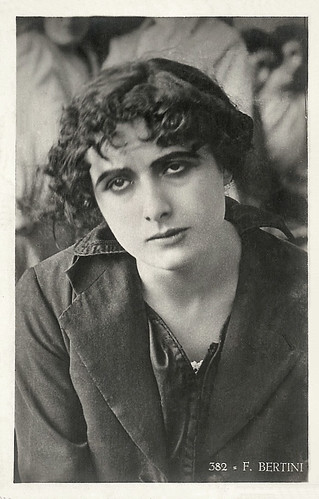
Italian postcard, no. 382. Photo: probably a publicity still for Assunta Spina (1914).
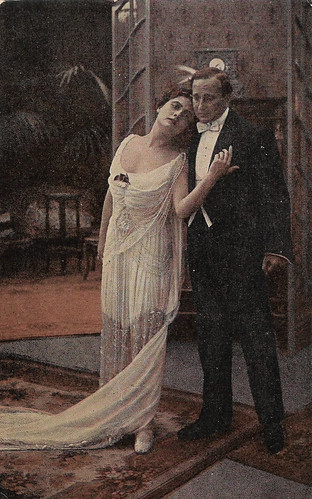
Spanish collector's card by Chocolate Pi, Barcelona, no. 3 of a series of 6 cards. Photo: Caesar Film. Francesca Bertini and Gustavo Serena in La signora delle camelieThe Lady of the Camellias (Gustavo Serena, 1915), based on the stage play by Alexandre Dumas fils.

Vintage postcard, no. 5560. Photo: Caesar Film, Roma. Francesca Bertini in Diana, l'affascinatrice/Diana the Seductress (Gustavo Serena, 1915).
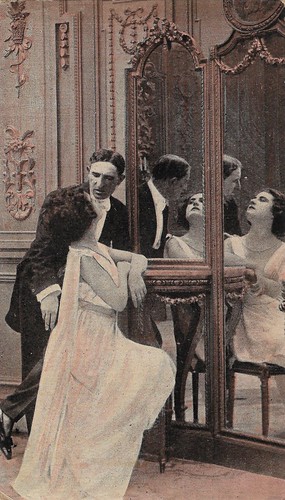
Spanish collectors card (cromo) by Chocolate Salas-Sabadell, Barcelona, no. 3 of 6 cards. Photo: Caesar Film. Francesca Bertini and Alfredo De Antoni in Andreina (Gustavo Serena, 1917).

Czech (Czechoslowak) postcard. Photo: Biografia, Praha. Th. Venta, Praha / Caesar Film. Francesca Bertini in Fedora (Giuseppe De Liguoro, Gustavo Serena, 1916).
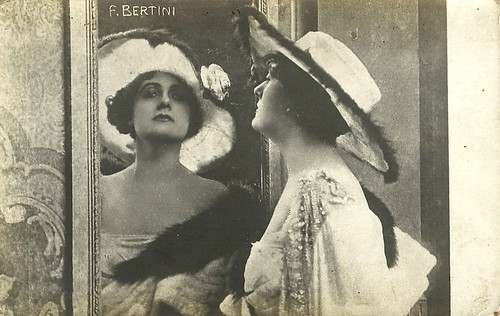
American postcard, monogram K Ltd. Francesca Bertini in Odette (Giuseppe De Liguoro, 1916).
Suffering demimondaine
In 1915, producer Giuseppe Barattolo lured Francesca Bertini to his company Caesar Film, where eventually she had her own production company Bertini Film, from 1918 onward. At Caesar Film, she played one of her best roles, Margherita Gauthier. La signora dalle camelie/The Lady of the Camellias (Gustavo Serena, 1915) was based on Alexandre Dumas fils' classic stage play 'La dame aux camélias', which again was the basis for Giuseppe Verdi's classic opera 'La Traviata'. It's the tragic story of a tuberculosis-ridden, suffering demimondaine who wants to get rid of her past and settle down with her lover, but this is denied, first by society (his father) and then by fate (her own illness and premature death).
The drama inspired many actresses. In 1915, 'La dame aux camélias' had already been filmed twice, first with Vittoria Lepanto (1909) and later by the great French actress Sarah Bernhardt (1911). In 1915, Bertini's rival Hesperia made a competing version of La signora dalle camelie (Baldassarre Negroni, 1915) and in the US Clara Kimball Young made another version (1915).
In the following decades, versions followed starring Theda Bara (1917), Erna Morena (1917), Pola Negri (1920), Alla Nazimova (1921), Sybil Thorndike (1922), Tora Teje (1925), Norma Talmadge (1926), Yvonne Printemps 1934), Greta Garbo (1936), Micheline Presle (1953), Maria Felix (1954), Sara Montiel (1962), Isabelle Huppert(1981), Teresa Stratas (1983), etc.
Bertini became popular internationally. Her sophistication was emulated around the world by female filmgoers. Reputedly, she earned $175,000 in 1915 - a record for the time. Especially in Assunta Spina, she developed the current acting techniques of film actresses by making them soberer, banning broad gestures or the mincing ways of the Diva. She is one of the first film actresses to focus on reality, rather than on a dramatic stereotype, an anticipation of Neorealistic canons.
The expression of authentic feelings was the key to Bertini's success in many films. She could perform with success as the languid decadent heroine as well as the popular common woman. Among her most popular films were Odette (Giuseppe De Liguoro, 1916), Fedora (Gustavo Serena, Giuseppe De Liguoro, 1916), Tosca (Alfredo De Antoni, 1918) and Frou-Frou (Alfredo De Antoni, 1918), films over which French critic Louis Delluc was enthusiastic. In the early 1920s, popular films were a.o. L'ultimo sogno/The last dream (Roberto Roberti, 1920) and La donna nuda/The naked truth (Roberto Roberti, 1922) opposite Angelo Ferrari. The director of these films, Roberto Roberti, was the father of Spaghetti Western genius Sergio Leone.

Italian postcard by Ed. Vettori, Bologna. Francesca Bertini als Tosca and Alfredo De Antoni as baron Scarpia in Tosca (Alfredo De Antoni, 1918).

Spanish collectors card by Chocolat Imperiale, no. 15. Photo: Pinto, Roma / Caesar Film. Francesca Bertini in Frou-Frou (Alfredo De Antoni, 1918), adapted from the play by Meilhac and Halevy.

Italian postcard, Ed. G. Vettori, Bologna, no. 525. Francesca Bertini and Amleto Novelli in La piovra/The Octopus (Edoardo Bencivenga 1919).

Italian postcard by G.B. Falci, Milano. Photo: publicity still for La giovinezza del diavolo/The youth of the devil (Roberto Roberti, 1922).
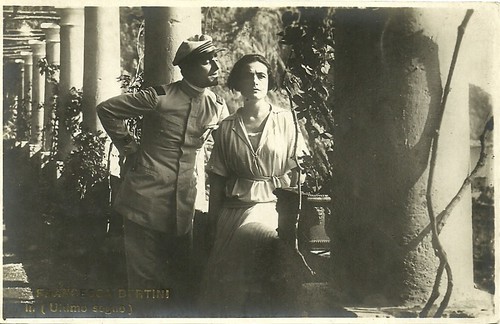
Italian postcard by Ed. G.B. Falci, Milano. Photo: Francesca Bertini in L'ultimo sogno/The last dream (Roberto Roberti, 1921). The man could be the male protagonist, played by Mario Parpagnoli.

Italian postcard. Ed. G.B. Falci, Milano. Francesca Bertini in L'ultimo sogno/The last dream (Roberto Roberti, 1921).
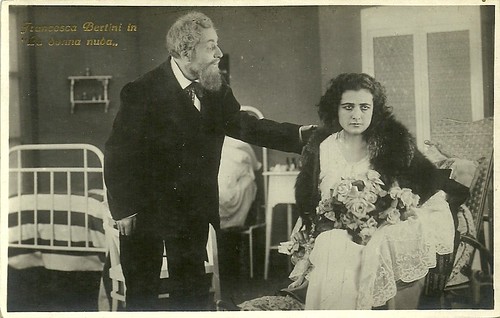
Italian postcard by Ed. G.B. Falci, Milano. Francesca Bertini in the Henry Bataille adaptation La donna nuda (Caesar Film, 1920), directed by Roberto Roberti. The man could be Franco Gennaro who plays the old painter Rouchard. After a suicide attempt over her persistently infidel lover, the painter Pierre Bernier (Angelo Ferrari), the model Lolette (Bertini) recovers in the hospital and decides to return to her old tutor Rouchard. The film was a remake of a film with Lyda Borelli, made in 1914 by Carmine Gallone.

Italian postcard by G.B. Falci, Milano. Photo: still from La donna nuda (1922) with Angelo Ferrari.
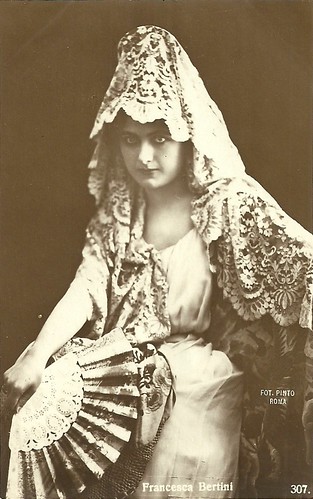
Italian postcard by Ed. A. Traldi, Milano, no. 307. Photo: Pinto, Roma. Francesca Bertini possibly in Consuelita (Roberto Roberti, 1925).
Countess Bertini
La giovinezza del diavolo/The devil's youth (Roberto Roberti, 1922) was a remake of the female Faustian tale of Rapsodia satanica/Satanic Rhapsody (Nino Oxilia,1917), starring another silent diva, Lyda Borelli. But by the 1920s, Borelli had retired from stage and screen, after a wealthy and aristocratic marriage, even if her films lingered on in the cinemas. The director of La giovinezza del diavolo was Roberto Roberti, but the film bore its quality mark through the artistic supervision of Gabriellino D'Annunzio, the son of the famous poet, who just had filmed La nave, with D'Annunzio's mistress, dancer Ida Rubinstein. La giovinezza del diavolo had an unlucky life. It received its censorship card only two years after production and was finally released in 1925 when the diva trend was definitively over. Only Raimondo Van Riel received praise for his part as Mefistofeles.
In 1921 Bertini married Count and banker Paul Cartier. After a decade of divadom, she withdrew from filming. She moved to Paris, but when her husband died, she moved back to Rome, where she would remain until her death. In order to take care of her son, she returned to the film sets, and thus in the second half of the 1920s she made a comeback.
She acted in a handful of late silent Franco-German co-productions, opposite established actors such as Jean Angelo, Fritz Kortner and Rudolf Klein-Rogge: La fin de Monte Carlo/The End of Monte Carlo (Henri Étiévant, Mario Nalpas, 1926), Mein Leben für das Deine/Odette (Luitz-Morat, 1927), Tu m'appartiens/You Belong to Me (Maurice Gleize, 1928), and La possession (Léonce Perret, 1929). She also acted in the multilingual Königin einer Nacht/Queen for a Night (Marcel L'Herbier, 1930; also shot in a French and Italian version) and Odette (Jacques Houssin, Giorgio Zambon, 1934; shot in a French and Italian version). The latter was the third version of Odette, based on a Stella Dallas-like tearjerker written by Victorien Sardou.
In 1914, Bertini had already performed in an Odette-like film, Sangue bleu/Blue Blood (Nino Oxilia, 1914), which narrative is close to that of Odette. In both versions, she expressed the deep grief of a well-bred but fallen woman who loses her child because of a divorce. Years later, she is allowed to see her child once more, pretending to be a friend of the child's mother, and then she commits suicide. Bertini continued to act with some regularity until 1930. From then on she made each decade one film. In 1976, Bernardo Bertolucci was able to convince her to emerge from her stubborn silence, accepting a role of a nun, Sister Desolata, in Novecento/1900 (Bernardo Bertolucci, 1977). This was to be her last performance in a feature film.
In 1982, Francesa Bertini was the subject of the documentary L'ultima Diva/The Last Diva (Gianfranco Mingozzi, 1982). Shot in her early 90s, she was as sharp and commanding as ever. Bertini was also one of the Divas featured in Peter Delpeut's beautiful compilation film Diva dolorosa (1999). She died in 1985 in Rome, at the age of 93. Several of her films were found and restored, but many others are still lost. If you want to see some of her work: we recommend Sangue bleu/Blue Blood (1914), Assunta Spina (1915), and L'ultima Diva/The Last Diva (1982) which were released on DVD. On the Eye film player, you can watch Diva dolorosa (1999).
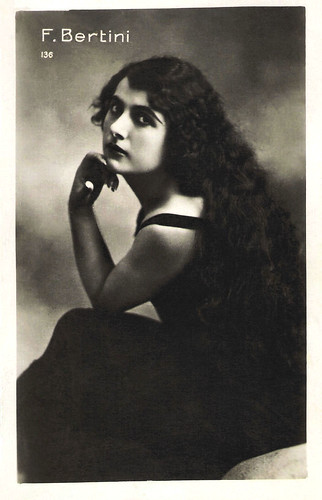
Italian postcard by G. Vettori, Bologna, no. 136.
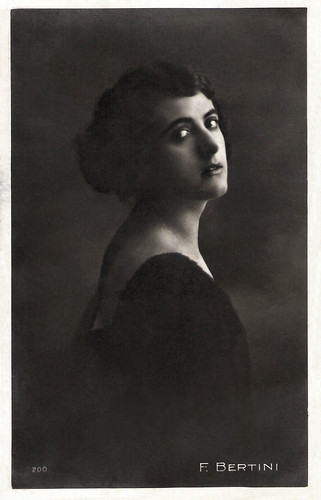
Italian postcard by G. Vettori, Bologna, no. 290. Sent by mail in 1927.

Vintage postcard, no. 7484.

German postcard by Ross Verlag, Berlin, no. 723/3, 1925-1926.

German postcard by Ross Verlag, Berlin, no. 723/4, 1925-1926.

German postcard by Ross Verlag, Berlin, no. 723/5, 1925-1926.
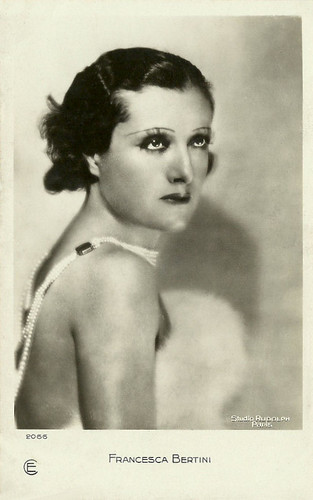
French postcard by Editions Cinémagazine (EC), no. 2066. Photo: Studio Rudolph, Paris. Collection: Didier Hanson.
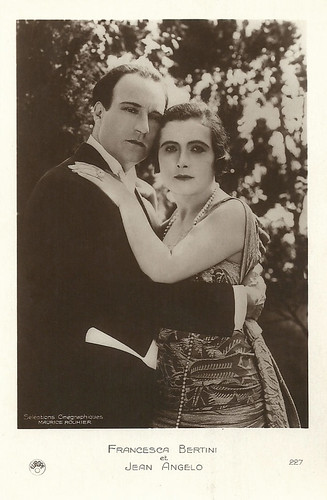
French postcard by Europe, no. 227. Photo: Sélections Cinégraphiques Maurice Rouhier. Jean Angelo and Francesca Bertini in the late silent film La fin de Monte-Carlo/The end of Monte Carlo (Henri Étievant, Mario Nalpas, 1927). In this film, Bertini plays Cora, a woman who suspects Jacques (Angelo) to have killed her husband. Still, she falls in love with him and they live their romance in Monte-Carlo. When Cora's father is desperately in need of money, Jacques takes over of battleship and menaces to bomb Monte-Carlo if the casino doesn't give him money...

Italian postcard by Italian distributor S.A. Stefano Pittaluga, no. 338. Francesa Bertini and Angelo Ferrari in Mein Leben für das Deine/My Life for Yours (Luitz-Morat 1928), based on Victorien Sardou's play 'Odette', and released in Italy under the same title. Bertini had already played in an Italian version, Odette (1916), and would do it again in the sound era in a French version, Odette (1935).

Italian postcard by S.A. Pittaluga, no. 341. Francesca Bertini and Fritz Kortner in Mein Leben für das Deine/My Life for Yours (Luitz-Morat, 1928).

Austrian postcard by Iris-Verlag, no. 5171. Photo: Verleih Philipps & Co.
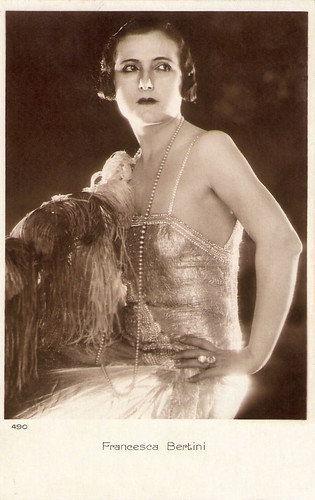
French postcard: Editions Cinémagazine, Paris, no. 490. This card must be from Bertini's career in the late 1920s. In Mein Leben für das Deine (an incomplete copy was found at the former Netherlands Filmmuseum (now Eye Filmmuseum) she holds the same enormous fan of ostrich feathers as the one on this postcard. Here Francesca Bertini is not the young star anymore, but what a glamorous light, what a dress and what a pose!

Italian postcard. Censorship sign by Ufficio Rev. Stampa, no. 894, Milano, 25-5-1917. Design: Tito Corbella.
Sources: Gianfranco Mingozzi (Francesca Bertini), Monica Dall’Asta (Women's Film Pioneer Project), David Melville (IMDb), Volker Boehm (IMDb), Greta de Groat (Unsung Divas of the Silent Screen), Wikipedia, and IMDb.
No comments:
Post a Comment